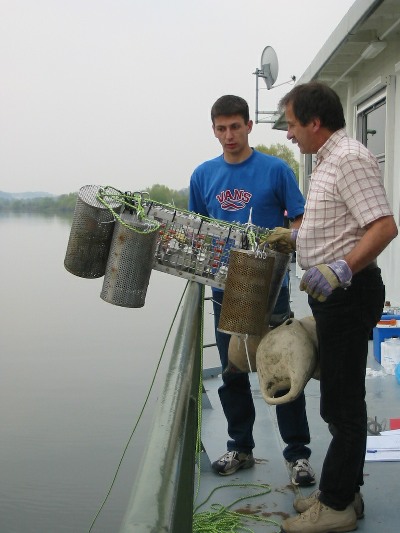The challenge
Taking samples of river water using the conventional method of filling bottles by hand can be costly and time consuming. Results obtained from ‘spot’ samples provide, at best, only a snapshot of pollutants that may have been present at the time of sampling, making interpretation of results problematic. Time lags between sampling, analysis and re-sampling also introduce delays that preclude timely response. Improved water quality sampling instrumentation is essential if these multiple problems are to be overcome for regulators and the water industry.
The solution
Chemcatcher® is a passive sampling device developed by researchers at the University of Portsmouth, and Chalmers University of Technology in Sweden. It measures time weighted averaged (TWA) concentrations of polar (e.g. pharmaceuticals and personal care products), and non-polar pollutants (e.g. polyaromatic hydrocarbons and some pesticides), heavy metals (e.g. cadmium, copper, lead and zinc) and some radionuclides (e.g. caesium-137) in water. It is also used in semi-quantitative mode for investigative monitoring, for example for the detection of sources of pollution in a catchment.

Chemcatcher® before deployment
Chemcatcher® can be deployed in-situ over extended periods of time (typically days to months) following which the samplers are retrieved from the field and the contaminants accumulated in the receiving phase are eluted and their concentrations measured using conventional analytical instrumentation.
A collaboration with South West Water, Natural Resources Wales and the Westcountry Rivers Trust led to the first riverine trials of Chemcatcher® for monitoring acid herbicides. Devices were deployed over a 25-mile stretch of the River Exe in May 2013 timed to coincide with known agricultural application of these herbicides. The River Lowman was identified as a previously unknown major source of these pollutants; a second field trial was carried out to identify other potentially problematic sub-catchments.
Resulting benefits
The Chemcatcher® sampler is being used internationally by researchers and commercial end users to provide cost-effective measurements of the concentration of pollutants in water over time.
“We are really pleased with the results obtained from the River Exe trial so far,” said Lewis Jones of South West Water. “The deployment of passive samplers in a catchment – and the ability to focus down to sub-catchments and individual tributaries – will be crucial in both targeting our catchment management interventions and assessing the subsequent improvements in water quality.”
Future directions
Due to the success of this trial, further monitoring campaigns within the catchment are being planned using various configurations of the Chemcatcher. These will focus on other problematic pesticides (e.g. metaldehyde) and identifying pharmaceutical residues and personal care products.
Vrana, Bran, Mills, Graham, Dominiak, Eva and Greenwood, Richard. Calibration of the Chemcatcher passive sampler for the monitoring of priority organic pollutants in water. Environ Polln 2006; 142(2), 333-343.
Allan, Ian, Booij, Kees, Paschke, Albrecht, Vrana, Bran, Mills, Graham and Greenwood Richard. Field performance of seven passive sampling devices for monitoring of hydrophobic substances. Environ Sci & Technol 2009; 43(14), 5383-5390.
Mills, Graham, Fones, Gary, Booij, Kees and Greenwood, Richard (2011) Passive sampling technologies. In: Chemical marine monitoring: policy framework and analytical trends. John Wiley & Sons, Chichester, pp. 397-432. ISBN 9780470747650.
None listed.
Customers:



Sources of funding
EU 4th Framework - Development of a passive sampling device to monitor organic and inorganic pollutants in the aquatic environment, £120,120, 1997-2000.
EU 5th Framework - Standardised Aquatic Monitoring of Priority Pollutants Using Passive Sampling, £272,000, 2002-2005.
EU 6th Framework - Screening Methods for Water Data Information in Support of the Implementation of the Water Framework Directive, £250,000, 2004-2007.
Regional Development Agency - Proof of concept of the use of prototype passive samplers for forensic and investigative monitoring of discharges to drains and wastewater networks, £49,990, 2006-2007.
CommercialiSE PoCKeT - Development of advanced robust body for the Chemcatcher® passive sampler to enable mass production of a low cost device for monitoring water quality, and to underpin future commercial development, £34,000, 2007.






 The Water Security Knowledge Exchange Portal supports the objectives of the
The Water Security Knowledge Exchange Portal supports the objectives of the 